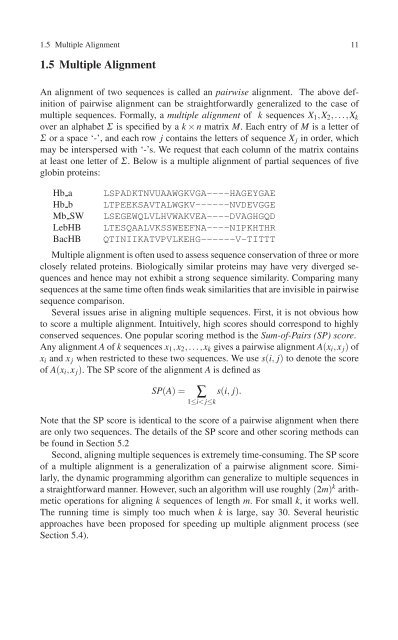You also want an ePaper? Increase the reach of your titles
YUMPU automatically turns print PDFs into web optimized ePapers that Google loves.
1.5 Multiple Alignment 11<br />
1.5 Multiple Alignment<br />
An alignment of two sequences is called an pairwise alignment. The above definition<br />
of pairwise alignment can be straightforwardly generalized to the case of<br />
multiple sequences. Formally, a multiple alignment of k sequences X 1 ,X 2 ,...,X k<br />
over an alphabet Σ is specified by a k × n matrix M. Each entry of M is a letter of<br />
Σ or a space ‘-’, and each row j contains the letters of sequence X j in order, which<br />
may be interspersed with ‘-’s. We request that each column of the matrix contains<br />
at least one letter of Σ. Below is a multiple alignment of partial sequences of five<br />
globin proteins:<br />
Hb a LSPADKTNVUAAWGKVGA----HAGEYGAE<br />
Hb b LTPEEKSAVTALWGKV------NVDEVGGE<br />
Mb SW LSEGEWQLVLHVWAKVEA----DVAGHGQD<br />
LebHB LTESQAALVKSSWEEFNA----NIPKHTHR<br />
BacHB QTINIIKATVPVLKEHG------V-TITTT<br />
Multiple alignment is often used to assess sequence conservation of three or more<br />
closely related proteins. Biologically similar proteins may have very diverged sequences<br />
and hence may not exhibit a strong sequence similarity. Comparing many<br />
sequences at the same time often finds weak similarities that are invisible in pairwise<br />
sequence comparison.<br />
Several issues arise in aligning multiple sequences. First, it is not obvious how<br />
to score a multiple alignment. Intuitively, high scores should correspond to highly<br />
conserved sequences. One popular scoring method is the Sum-of-Pairs (SP) score.<br />
Any alignment A of k sequences x 1 ,x 2 ,...,x k gives a pairwise alignment A(x i ,x j ) of<br />
x i and x j when restricted to these two sequences. We use s(i, j) to denote the score<br />
of A(x i ,x j ). The SP score of the alignment A is defined as<br />
SP(A)=<br />
∑<br />
1≤i< j≤k<br />
s(i, j).<br />
Note that the SP score is identical to the score of a pairwise alignment when there<br />
are only two sequences. The details of the SP score and other scoring methods can<br />
be found in Section 5.2<br />
Second, aligning multiple sequences is extremely time-consuming. The SP score<br />
of a multiple alignment is a generalization of a pairwise alignment score. Similarly,<br />
the dynamic programming algorithm can generalize to multiple sequences in<br />
a straightforward manner. However, such an algorithm will use roughly (2m) k arithmetic<br />
operations for aligning k sequences of length m. For small k, it works well.<br />
The running time is simply too much when k is large, say 30. Several heuristic<br />
approaches have been proposed for speeding up multiple alignment process (see<br />
Section 5.4).

















